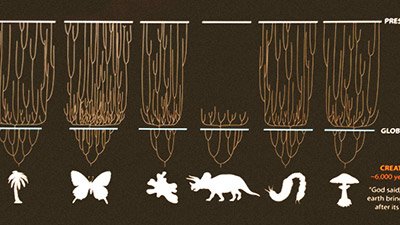
Nile Crocodile Actually Two Separate Species
If you swim with African crocodiles, better check their I.D. first.
News Sources
- Nature: “Nile Crocodile Is Two Species”
- Discover.com “Nile Crocodile Cs Actually Two Species (and the Egyptians Knew It)”
The ancient historian Herodotus, visiting Egypt in the fifth century BC, wrote about relatively tame crocodiles bred for temple worship. Crocodiles living in the Nile today, however, are far from tame. Some recent genetic detective work, however, has tracked down the more mild-mannered version of this “living fossil” and connected it with the mummies.
Actually, in the 1970s, the crocodile leather industry was looking for a variety with fewer bony scutes. A researcher by the name of Fuchs suggested these crocodiles, but he was not taken seriously. (Since then, his publication “Die Krokodilhaut” is commonly referenced in works concerning crocodiles.) But much earlier, in 1807, the French naturalist Geoffrey Saint-Hilaire described the smaller tamer crocodile and acknowledged its historical significance, saying, “This sacred crocodile is called C. suchus.”
Crocodile geneticist Ekon Hekkala got a tissue sample for genetic sequencing from a rather odd source: an associate touring near a crocodile-infested oasis in Chad was invited by his guide to take a dip. The crocodiles didn’t mind at all. The tissue sample thus obtained—from a crocodile which had been killed by a rock without any help from the researchers—didn’t match the Nile croc specimens Hekkala was examining. 123 living crocodile and 57 mummified crocodile specimens later, Hekkala has determined that the tamer crocodiles are a separate species. (Actually, the samples from some mummified crocodiles didn’t work out very successfully, but the ones looted by Napoleon and stored in Paris did yield usable specimens for DNA analysis.)
But despite the minimal visible differences between crocodile species—some differences in the skulls and in scale patterns—she says the genetic differences are substantial.
“Crocodiles are generally very hard to tell apart from their exterior features,” Hekkala says. But despite the minimal visible differences between crocodile species—some differences in the skulls and in scale patterns—she says the genetic differences are substantial. In fact, the large aggressive C. niloticus is genetically quite similar to the Caribbean species but not at all similar to C. suchus.
Although docile crocodiles contentedly swimming with natives in Mauritanian caves1 have turned out to be C. suchus also, C. suchus may qualify for the ranks of endangered species. It is already extinct near the Nile, and there is evidence its population and habitats in western Africa are shrinking.
Hekkala points out that the crocodile is not really an unchanged “living fossil” as she can show it has speciated significantly. Yet speciation does not revoke “living fossil” status. After all, as she pointed out herself, externally, crocodiles are pretty much alike. They’re also pretty much like many crocodile fossils. A “living fossil” is just a living organism that resembles the fossilized ones, although the ones we get most excited about are the ones thought to be extinct.
We can only guess about the features of the original created crocodile kind (or kinds). The news has recently shown us a live captured 21-foot, 2370-pound crocodile whose future is secure as mascot of a new ecotourism park in the southern Philippines.2 We’ve also seen a recent report of a fossilized 20-foot crocodile with a 42-foot fossilized snake in a Palaeocene layer in a Colombian mine.3
Like saltwater crocodiles, the true Nile crocodile is certainly not one to make friends. But the C. suchus’s milder disposition should be a reminder to us that the world God created was free of the violence and aggression we see in the animal kingdom today. Indeed, all of creation has been groaning (Romans 8:20–22) since Adam brought sin into the world. The death and violence we see in the world are not the natural normal created state of things; they are intruders. And we can be thankful that thanks to Christ’s sacrifice, not only can we as Christians look forward to eternal salvation for our souls, but also an ultimate end to the death and suffering we see in the world today.
Further Reading
For More Information: Get Answers
Remember, if you see a news story that might merit some attention, let us know about it! (Note: if the story originates from the Associated Press, FOX News, MSNBC, the New York Times, or another major national media outlet, we will most likely have already heard about it.) And thanks to all of our readers who have submitted great news tips to us. If you didn’t catch all the latest News to Know, why not take a look to see what you’ve missed?
(Please note that links will take you directly to the source. Answers in Genesis is not responsible for content on the websites to which we refer. For more information, please see our Privacy Policy.)
Footnotes
- “Hunt for the lost crocs of the Pharaohs,” Western Daily Press, October 2, 2003.
- “6.4-m Giant Crocodile Captured Alive in Philippians - World Record Holder,” Bazics.net, September 6, 2011, http://www.bazics.net/2011/09/64-m-crocodile-captured-alive-in.html.
- “Big Fossil Croc May Have Competed with Giant Snake,” BBC News, September 15, 2011, http://www.bbc.com/news/science-environment-14933629.

Answers in Genesis is an apologetics ministry, dedicated to helping Christians defend their faith and proclaim the good news of Jesus Christ.
- Customer Service 800.778.3390
- Available Monday–Friday | 9 AM–5 PM ET
- © 2025 Answers in Genesis

